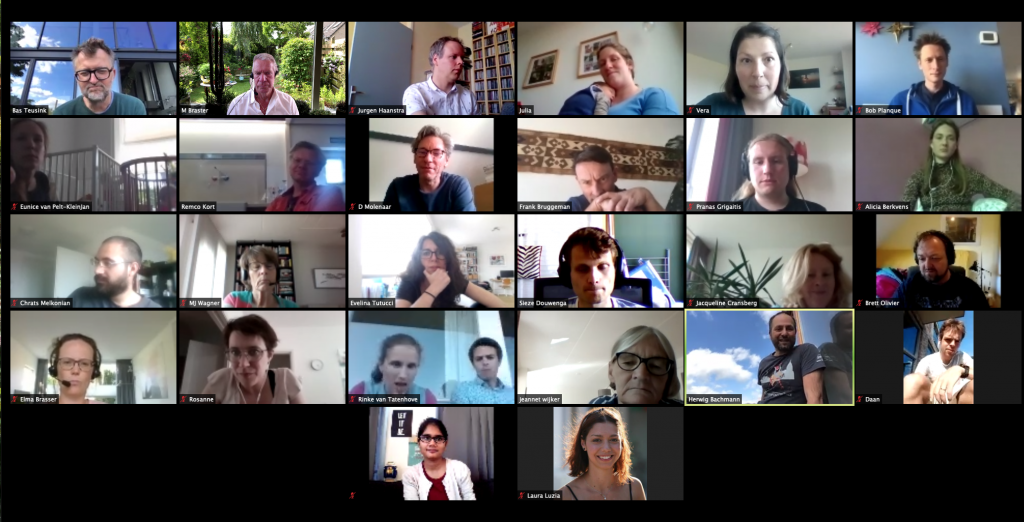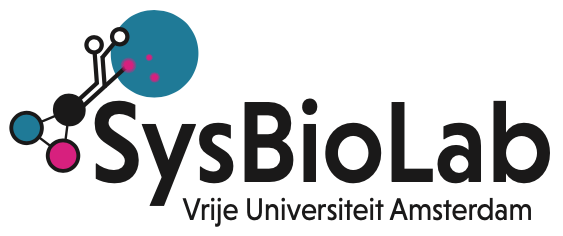Adaptive changes of sediment microbial communities associated with cleanup of oil spills in Nigerian mangrove forests.
Author: Martin Braster
Eunice won the LABIP poster award for excellent research with industrial relevance
At the13th international symposium on lactic acid bacteria Eunice van Pelt – KleinJan, PhD student in Bas Teusink’s group, won the LABIP poster award for excellent research with industrial relevance. The poster “Proteome constraints shape Lactococcus lactis’ metabolic behaviour” shows that we can understand the changes and choices in energy metabolism that Lactococcus lactis (needed a.o. for Gouda cheese) makes, based on the protein costs and energy yield of the metabolic strategies. As such we could rationalize why certain amino acids are taken up in excess or not at all. The work helps rationalizing how conditions may affect the fermentative behaviour of lactic acid bacteria.

‘Swim or grow? Reserach article with Remco.
Research article with Remco: Different Resource Allocation in a Bacillus subtilis Population Displaying Bimodal Motility.
Collaboration between TNO, UvA and VU about resource allocation in Bacillus subtilis leads to new study published in Journal of Bacteriology this month (June 2021).
Publication by Chrats: High biodiversity in a benzene-degrading nitrate-reducing culture is sustained by a few primary consumers.
A key question in microbial ecology is what the driving forces behind the persistence of large biodiversity in natural environments are. We studied a microbial community with more than 100 different types of species which evolved in a 15-years old bioreactor with benzene as the main carbon and energy source and nitrate as the electron acceptor. Using genome-centric metagenomics plus metatranscriptomics, we demonstrate that most of the community members likely feed on metabolic left-overs or on necromass while only a few of them, from families Rhodocyclaceae and Peptococcaceae, are candidates to degrade benzene. We verify with an additional succession experiment using metabolomics and metabarcoding that these few community members are the actual drivers of benzene degradation. As such, we hypothesize that high species richness is maintained and the complexity of a natural com- munity is stabilized in a controlled environment by the interdependencies between the few benzene degraders and the rest of the community members, ultimately resulting in a food web with different trophic levels.
Article published by Paul : Effects of DNA preservation solution and DNA extraction methods on microbial community profiling of soil
Abstract
Microbial community profiling using high-throughput sequencing relies in part on the preservation of the DNA and the effectiveness of the DNA extraction method. This study aimed at understanding to what extent these parameters affect the profiling. We obtained samples treated with and without a preservation solution. Also, we compared DNA extraction kits from Qiagen and Zymo-Research. The types of samples were defined strains, both as single species and mixtures, as well as undefined indigenous microbial communities from soil. We show that the use of a preservation solution resulted in substantial changes in the 16S rRNA gene profiles either due to an overrepresentation of Gram-positive bacteria or to an underrepresentation of Gram-negative bacteria. In addition, 16S rRNA gene profiles were substantially different depending on the type of kit that was used for extraction. The kit from Zymo extracted DNA from different types of bacteria in roughly equal amounts. In contrast, the kit from Qiagen preferentially extracted DNA from Gram-negative bacteria while DNA from Gram-positive bacteria was extracted less effectively. These differences in kit performance strongly influenced the interpretation of our microbial ecology studies.
https://link.springer.com/article/10.1007/s12223-021-00866-0
Nature review article by Evelina : Intracellular mRNA transport and localized translation.
Abstract
Fine-tuning cellular physiology in response to intracellular and environmental cues requires precise temporal and spatial control of gene expression. High-resolution imaging technologies to detect mRNAs and their translation state have revealed that all living organisms localize mRNAs in subcellular compartments and create translation hotspots, enabling cells to tune gene expression locally. Therefore, mRNA localization is a conserved and integral part of gene expression regulation from prokaryotic to eukaryotic cells. In this Review, we discuss the mechanisms of mRNA transport and local mRNA translation across the kingdoms of life and at organellar, subcellular and multicellular resolution. We also discuss the properties of messenger ribonucleoprotein and higher order RNA granules and how they may influence mRNA transport and local protein synthesis. Finally, we summarize the technological developments that allow us to study mRNA localization and local translation through the simultaneous detection of mRNAs and proteins in single cells, mRNA and nascent protein single-molecule imaging, and bulk RNA and protein detection methods.
Welkom Julius
Julius Battjes will work on the ZeroYeast project together with Chr Hansen, and make a proteome-constrained model of Pichia kluyveri with the aim to transfer knowledge from S cerevisiae to another industrial yeast.
Zoom Celebration
Zoom Celebration at SysBioLab.

Rinke has a tenure track position in Delft, Bas got a new project granted, and Frank published a massive paper in Current Biology together with Johan, all on the same (Mon)day.
With such good news it is time to celebrate! Lets open the bottle (that will be delivered to you today) together.
Enjoy and stay healthy! Rinke, Bas and Frank
On behalf of all of us, Congratulations and thank you for the surprise.
A special thanks goes to the delivery boy! Thanks for bringing it to us.
Paper by Niclas, Johan and Frank
Biphasic Cell-Size and Growth-Rate
Homeostasis by Single Bacillus subtilis Cells
Abstract
The growth rate of single bacterial cells is continuously disturbed by random fluctuations in biosynthesis rates and by deterministic cell-cycle events, such as division, genome duplication, and septum formation. It is not understood whether, and how, bacteria reject these growth-rate disturbances. Here, we quantified growth and constitutive protein expression dynamics of single Bacillus subtilis cells as a function of cell-cycle progression. We found that, even though growth at the population level is exponential, close inspection of the cell cycle of thousands of single Bacillus subtilis cells reveals systematic deviations from exponential growth. Newborn cells display varying growth rates that depend on their size. When they divide, growth-rate variation has decreased, and growth rates have become birth size independent. Thus, cells indeed compensate for growth-rate disturbances and achieve growth-rate homeostasis. Protein synthesis and growth of single cells displayed correlated, biphasic dynamics from cell birth to division. During a first phase of variable duration, the absolute rates were approximately constant and cells behaved as sizers. In the second phase, rates increased, and growth behavior exhibited characteristics of a timer strategy. These findings demonstrate that, just like size homeostasis, growth-rate homeostasis is an inherent property of single cells that is achieved by cell-cycle-dependent rate adjustments of biosynthesis and growth.
An integrative view on how metabolic fluxes sustain growth of liver cancer cells
Jurgen Haanstra and Bas Teusink collaborated with several research groups on interdisciplinary research combining wetlab experiments with computational models.
Haanstra and Teusink collaborated with research groups in Gothenburg (Sweden), Groningen and Heidelberg (Germany). Their work on a quantitative analysis of amino acid metabolism in liver cancer, with Jurgen as co-first author, was just published in PNAS.
Metabolic changes are a well-known hallmark of cancer, but an integrative view on how metabolic fluxes sustain (high) growth rates is often lacking. In this study the authors used a combination of experimental measurements and computational modelling to understand metabolism of HepG2 liver cancer cells during in vitro growth at different glucose levels. The measured fluxes of glucose, pyruvate, lactate and amino acids during growth were integrated with a genome-scale reconstruction of liver cancer metabolism to estimate the intracellular metabolic fluxes that should be operational to sustain this growth.
The analysis published in PNAS shows that many amino acids are consumed at rates exceeding the need for biomass formation. The intracellular fluxes indicate that a large part of the glutamine that is consumed is metabolised in the cytosol to support biosynthetic processes. A large part of the glutamate that results from these processes is excreted. This led to the hypothesis that inhibition of glutamate export would decrease growth and this was validated in an experiment where glutamate export was inhibited.
The work shows that genome-scale metabolic models constrained with measured fluxes can be used to estimate the effects of inhibitors of metabolic reactions.

Recent Comments